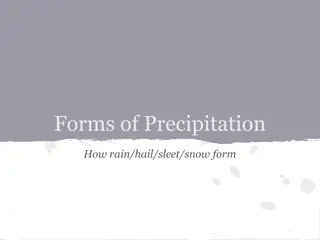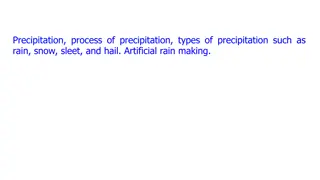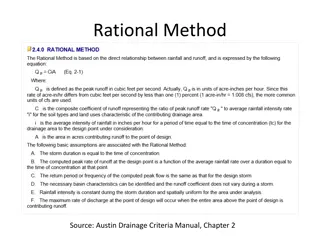Understanding Different Climate Types and Regions
The climate is shaped by temperature, precipitation, and wind, creating global patterns and diverse climate regions. From tropical wet climates to continental warm summers, each region has unique characteristics based on temperature and precipitation. By understanding these climate types, we can app
1 views • 7 slides
Hydrologic Modeling Methods in HEC-HMS: A Comprehensive Overview
Explore the transformative methods within HEC-HMS hydrologic modeling, including unit hydrograph derivation, excess precipitation transformation, hydrograph illustration, surface transform methods, and concepts like the kinematic wave and 2D diffusion wave. Learn about the unit hydrograph, kinematic
0 views • 41 slides
Insights into Raindrop Size Distribution and Precipitation Intensity through Radar Technology
Vertical momentum of impacting raindrops can be converted into an electric pulse to analyze raindrop size distribution. Disdrometers using video cameras can directly count raindrops for sizing. Radar technology provides superior data on precipitation accumulation and intensity by measuring radar ref
4 views • 9 slides
Understanding Precipitation and Rainfall Patterns in Hydrology
Exploring the various forms of precipitation like rainfall, snowfall, hail, and sleet, this lesson delves into the complexities of precipitation forms, intensity classifications, types of rain gauges, and methods for correcting deficiencies in rainfall data. Through detailed descriptions and images,
1 views • 39 slides
High-Intensity Sweeteners Market Projected to Reach $5.37 Billion by 2034
The global high-intensity sweeteners market is projected to experience significant growth through 2034. High-intensity sweeteners are widely used as sugar substitutes due to their ability to provide the desired sweetness without the calories. \n
0 views • 5 slides
Impact of Temperature and Precipitation on Global Pollen Trends and Human Health
Pollen significantly affects millions of Americans with allergic rhinitis, asthma, and respiratory issues, resulting in substantial healthcare costs. This study investigates the effects of temperature and precipitation shifts on pollen production, tracking trends over time through literature reviews
0 views • 15 slides
Understanding Precipitation in Meteorology
Precipitation in meteorology is the result of atmospheric water vapor condensing and falling to Earth, a vital element of hydrology. It can occur in liquid or solid forms through processes like evaporation, cooling, condensation, and droplet growth. Different geographic and climate conditions impact
0 views • 17 slides
Hydrologic Modeling with Gridded Precipitation Data
Learn about utilizing gridded precipitation data for hydrologic modeling with HEC-HMS. Explore the advantages of spatially distributed precipitation sources such as RADAR and gauge comparisons, and understand the various national and regional products available. Discover utilities for converting and
3 views • 14 slides
Understanding Precipitation in Pharmacy and Chemistry
Precipitation is a crucial process in chemistry and pharmacy, where solid particles are separated from a clear liquid solution. This method is used for various purposes like obtaining fine particles, purifying powders, and preparing pharmaceutical substances. Examples include calcium carbonate, ammo
7 views • 10 slides
Understanding Antigen-Antibody Precipitation Reaction in Microbiology
Antigen-antibody precipitation reaction involves the formation of insoluble products when a soluble bivalent antibody interacts with a soluble antigen. This reaction leads to the formation of a visible precipitate known as a lattice. The mechanism of precipitation, including the prozone phenomenon,
0 views • 20 slides
Understanding Precipitation Titration in Analytical Chemistry
Precipitation titration is a method where a precipitate is formed by converting one reacting species. An example is the estimation of chloride using AgNO3, where AgCl is precipitated. The titration is based on the formation of precipitates, and suitable conditions, indicators, and methods are vital
0 views • 30 slides
Understanding Antigen-Antibody Interactions and Diagnostic Tests
Antigen-antibody interactions are essential in immunology, determining disease presence, blood types, and more. Diagnostic tests such as agglutination and precipitation reactions play a crucial role. Specimen collection involves obtaining blood samples for analysis, while precipitation reactions for
0 views • 22 slides
Understanding Light Intensity Variation in Different Sources
Explore the correlation between light intensity and efficiency in various light sources through an intriguing experiment. Delve into the theoretical framework and practical applications to grasp the essence of light intensity and its distribution. Uncover the factors influencing the efficiency of li
0 views • 21 slides
Contractions of Tropical Precipitation Under Global Warming
Aaron Donohoe's research focuses on the contraction of tropical precipitation with global warming, emphasizing the zonal mean and its implications for climate models. The results show a robust contraction and intensification of tropical precipitation in a warmer world. The width of tropical precipit
0 views • 12 slides
Insights into Precipitation Analysis for Transportation Applications
Delve into the utilization of precipitation data by state transportation agencies for road and bridge design, safety operations, and traveler information. Explore model components and the nature of precipitation events, along with challenges associated with spatial scale sampling. Discover the impor
4 views • 12 slides
Impact of Precipitation on Ocean Salinity: Study at University of Antananarivo
Juliette Soanaoly from the University of Antananarivo presents a study on the impact of precipitation on ocean salinity. The research explores the intercorrelation between rainfall and salinity, variability of precipitation in a specific study area, and the methodologies used to analyze the data ove
1 views • 17 slides
Understanding Light Intensity: Measuring Different Light Sources
Explore the concept of light intensity by measuring various light sources and their efficiency. Through practical experiments, understand the relationship between light intensity and the output of different light sources. Theoretical frameworks, practical applications, and key concepts are discussed
0 views • 21 slides
Effects of Down-Valley Flow on Precipitation Patterns and Microphysics
Down-valley flow in complex terrain areas like the Alps and British Columbia modifies precipitation patterns through diabatic cooling and melting effects. Observations from the OLYMPEX field campaign show how down-valley flow is influenced by both thermodynamics and pressure gradients, with signific
0 views • 15 slides
Protein Denaturation and Precipitation: Mechanisms and Effects
Protein denaturation is a process where proteins lose their native structure due to external factors like heat, strong acids, or bases. This leads to protein aggregation and precipitation. Different types of denaturation exist, including reversible and irreversible forms. Strong mineral acids can al
1 views • 21 slides
Forms of Precipitation and How They Form
Precipitation is any form of water that falls to earth and occurs when water evaporates into the atmosphere, saturates it, then condenses back into water. There are 5 main types of precipitation: rain, sleet, hail, snow, and freezing rain. Rain forms as water droplets in clouds collide and grow too
1 views • 14 slides
Understanding Precipitation: Forms and Types Explained
Precipitation, any form of moisture reaching Earth's surface from the atmosphere, encompasses various types like rain, snow, drizzle, glaze, sleet, and hail. Each type has unique characteristics, densities, and formation processes. Additionally, precipitation can be classified into convection, cyclo
1 views • 38 slides
Evaluation and Improvement of Cloud and Precipitation Physics in Hurricane Weather Forecasting
Yuqing Wang from the Department of Meteorology at the University of Hawaii worked on evaluating and enhancing cloud and precipitation physics in the operational Hurricane Weather Research and Forecast (HWRF) model. The project aimed to improve hurricane intensity and structure predictions, focusing
0 views • 18 slides
Academic Intervention Library Overview
Explore the Intervention Library for academic and behavior interventions, accessed through OKMTSS. Filter interventions by grade band, intensity level, and group size. Understand grade band considerations and intervention intensity tiers. Learn about the recommended group sizes and how to choose the
0 views • 15 slides
Ion Beam Intensity Enhancement Through Electron Heating in Collider Experiments
The study discusses electron heating of ions in collider experiments at the Collider V. ParkhomchukBINP facility in Novosibirsk. It explores the effects of electron cooling on ion beams, ion beam oscillations, losses, and ion beam intensity enhancement. Various factors such as ion charge, classical
0 views • 9 slides
Understanding Precipitation: Process, Types, and Artificial Rain Making
Precipitation occurs through the condensation of water vapors in the air. The process involves various types such as rain, snow, sleet, and hail, each formed differently - convectional, orographic, and frontal/cyclonic. Learn about the mechanisms behind precipitation, including the creation of artif
1 views • 25 slides
Understanding Cloud and Precipitation Processes in Atmospheric Science
This week's module focuses on measuring, predicting, and modeling single-column processes related to clouds and precipitation. Topics covered include ODE and PDE models, advection equations, orographic clouds, warm and cold cloud processes, condensation, warm-rain processes, and more. The importance
0 views • 17 slides
Enhancing Precipitation Interpolation Methods for High-Resolution Data Analysis
Accurate interpolation of precipitation data is crucial for various applications, especially in regions with limited data coverage like Greece. This study focuses on improving the creation of a precipitation atlas for Greece using daily observation analysis. By analyzing the reliability of the metho
0 views • 24 slides
Estimation of Precipitation over the OLYMPEX Domain during Winter 2015-2016
The study aims to evaluate precipitation products over the OLYMPEX domain during the winter of 2015-2016 by utilizing various data sources such as NOAA, NASA, and in-situ observations. The primary goal is to enhance the assessment of Global Precipitation Mission (GPM) products, focusing on regions w
0 views • 22 slides
Diagnosing Low-Topped Precipitation Events Using Satellite Imagery
Utilizing MODIS/VIIRS Night-Time Microphysics RGB Imagery combined with Proximity Soundings can enhance situational awareness and aid in diagnosing low-topped precipitation events. Various satellite images and data sources are analyzed to understand why heavy rain occurred in Havre, MT, despite mini
0 views • 17 slides
Understanding Intensity Noise and Angular Distribution Measurements in LED Selection
The measurements focus on intensity noise and angular distribution to address variations in LED performance observed in LIGO papers. The study aims to investigate intensity noise dependence on LED current, differences between LED batches, and comparisons between them.
0 views • 8 slides
Chicken Wing Sauce Consumer Test Analysis
Analysis of consumer preferences and feedback on different chicken wing sauces based on overall liking, flavor intensity, garlic flavor intensity, honey flavor intensity, and amount of sauce. The study includes crosstabulations and mean graphs to evaluate category liking attributes and jar assessmen
0 views • 12 slides
Understanding Antigen-Antibody Precipitation Reaction in Immunity
The humoral basis of immunity involves the specific reaction between antigens and antibodies, resulting in the formation of insoluble precipitates through a process called precipitation. This reaction plays a crucial role in immune responses against infectious diseases, influenced by factors like af
0 views • 16 slides
Austin Drainage Criteria Manual - Chapter 2 Resources
This collection of resources includes information on the Rational Method, Mannings N values, and Intensity-Duration-Frequency Curves from the Austin Drainage Criteria Manual Chapter 2. The Rational Method source and key data such as precipitation intensity and duration are highlighted with detailed
0 views • 4 slides
Protein Purification Techniques and Ammonium Sulfate Precipitation
Protein purification is a crucial process in biotechnology to isolate specific proteins from complex mixtures. Techniques such as exploiting physio-chemical properties, binding affinity tags, and biological activity are used. Ammonium sulfate precipitation, a common first step, involves adding incre
0 views • 60 slides
Impressive Impact of Recent El Niño-Fueled Storms in San Diego County
El Niño-driven storms in San Diego County led to above-average winter precipitation, with areas receiving over 5 inches of rain in just 3 days. This sudden increase has significantly boosted accumulated precipitation levels for the winter, especially in Southern California. The rapid rise in precip
1 views • 5 slides
Factors Affecting Algal Ecology: Light Intensity Impacts on Algae Growth and Composition
Light intensity plays a crucial role in the growth and composition of algae. Algae undergo photoadaptation processes to adjust to varying light levels, affecting their photosynthetic efficiency and cellular properties. High light intensity can lead to photoinhibition and changes in cellular composit
0 views • 19 slides
Increase in Precipitation Efficiency with Surface Warming
The study examines how surface warming affects precipitation efficiency in radiative-convective equilibrium. Various factors influencing precipitation efficiency, such as microphysical processes and climate sensitivity, are discussed. Model experiments are conducted to test the sensitivity of precip
0 views • 33 slides
Machine Learning Applications for EBIS Beam Intensity and RHIC Luminosity Maximization
This presentation discusses the application of machine learning for optimizing EBIS beam intensity and RHIC luminosity. It covers topics such as motivation, EBIS beam intensity optimization, luminosity optimization, and outlines the plan and summary of the project. Collaborators from MSU, LBNL, and
0 views • 23 slides
Methods for RNA Purification and Separation from DNA
Selective precipitation of RNA using Lithium Chloride (LiCl) and extraction with phenol at acidic pH are two common methods for separating RNA from DNA. LiCl forms a complex with RNA facilitating its precipitation, while acidic phenol solution helps stabilize RNA at pH 4-5 for extraction. TRIzol var
0 views • 7 slides
Challenges and Design of High-Intensity Accumulator for Neutrino Experiments
The presentation discusses the challenges faced in designing an accumulator for high-intensity particle beams in neutrino experiments at ESS Lund, with a focus on beam loss management, injection efficiency, and intense beam physics issues. The design considerations include beam holding capacity, bea
0 views • 30 slides







































